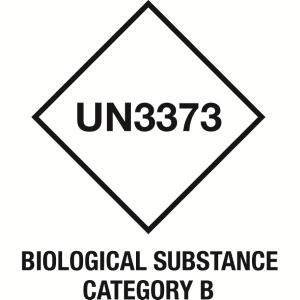Guide to the Packaging & Transportation of Biological Specimens by Road
PACKAGING INSTRUCTION P650 This packing instruction applies to UN 3373 (Diagnostic Specimens)
1. The packaging shall be of good quality, strong enough to withstand the shocks and loadings normally encountered during carriage, including transhipment between vehicles or containers and between vehicles or containers and warehouse as any removal from a pallet or over pack for subsequent manual or mechanical handling. Packaging shall be constructed and closed to prevent any loss if contents that might be caused under normal conditions of carriage by vibration or by changes in temperature, humidity or pressure.
2. The packaging shall consist of three components
a) a primary receptacle;
b) a secondary packaging; and
c) an outer packing.
3. Primary receptacles shall be packed in secondary packaging in such a way that, under normal conditions of carriage, they cannot break, be punctured or leak their contents into the secondary packaging. Secondary packaging shall be secured in outer packaging with suitable cushioning material. Any leakage of the contents shall not compromise the integrity of the cushioning material or of the outer packaging.
4. For carriage, the mark illustrated below shall be displayed on the external surface of the outer packaging on a background of a contrasting colour and shall be clearly visible and legible. The width of the line shall be at least 2mm; the letters and numbers shall be at least 6mm high.

5. The completed package shall be capable of successfully passing the drop test in 6.3.2.5. as specified in 6.3.2.3. and 6.3.2.4. except that the height of the drop shall not be less that 1.2m. The smallest external dimension of outer packaging shall be not less than 100mm.
6. For liquid substance:
a) The primary receptacle(s) shall be leak proof;
b) The secondary packaging shall be leak proof;
c) If multiple fragile primary receptacles are placed in a single secondary packaging, they shall be either individually wrapped or separated to prevent contact between them;
d) Absorbent material shall be placed between the primary receptacles(s) and the secondary packaging. The absorbent material shall be in quantity sufficient to absorb the entire contents of the primary receptacle(s) so that any release of the liquid substance will not compromise the integrity of the cushioning material or of the outer packaging;
e) The primary receptacle or the secondary packaging shall be capable of withstanding, without leakage, an internal pressure of 95 kPa (0.95 bar).
7. For solid substances:
a) The primary receptacle(s) shall be sift proof;
b) The secondary packaging shall be sift proof;
c) If multiple fragile primary receptacles are placed in a single secondary packaging, they shall be either individually wrapped or separated t prevent contact between them.
8. Refrigerated or frozen specimens: Ice, dry ice and liquid nitrogen
a) When dry ice or liquid nitrogen is used to keep specimens cold, all applicable requirements of ADR shall be met. When used, ice or dry ice shall be placed outside the secondary packaging or in the outer packaging or an over pack. Interior supports shall be provided to secure the secondary packaging in the original position after the ice or dry ice has dissipated. If ice is used, the outside packaging or over pack shall be leak proof. If carbon dioxide, solid (dry ice) is used, the packaging shall be designed and constructed to permit the release of carbon dioxide gas to prevent a build up of pressure that could rupture the packaging and the package (the outer packaging or the over pack) shall be marked “Carbon dioxide, solid” or “Dry ice”.
b) The primary receptacle and the secondary packaging shall maintain their integrity at the temperature of the refrigerant used as well as the temperatures and the pressures, which could result if refrigeration were lost.
9. Infectious substances assigned to UN 3373 which are packed and packages which are marked in accordance with this packing instruction are not subject to any other requirement in ADR.
10. Clear instructions on filling and closing such packages shall be provided by packaging manufacturers and subsequent distribution to the consignor or to the person who prepares the package (e.g. patient) to enable the package to be correctly prepared for carriage.
11. If any substance has leaked and has been spilled in a vehicle or container, it may not be reused until after it has been thoroughly cleaned and, if necessary, disinfected or decontaminated. Any other goods and articles carried in the same vehicle or container shall be examined for possible contamination.
Royal Mail requirements:
Royal Mail will only carry UN 3373 Diagnostic Specimens if they are packed following Packaging Instruction P650, and:
Are sent by first class post or Special Delivery and to inland addresses only
The packet is marked with the sender’s name, telephone number and address
TNT (Courier) requirements:
The “Nature and Quantity of Goods” box must contain the text “Biological Substance, Category B” and “UN 3373” on the Consignment note/Air Waybill.
The Dangerous Goods “YES” box must be ticked.
The name and telephone number of a “responsible person” must be written on the consignment note or on the package.
The package must carry the warning symbol bearing the text UN 3373, and the words “Biological Substance, Category B”.
Reference: WHO (updated June 2018)
You are here:

